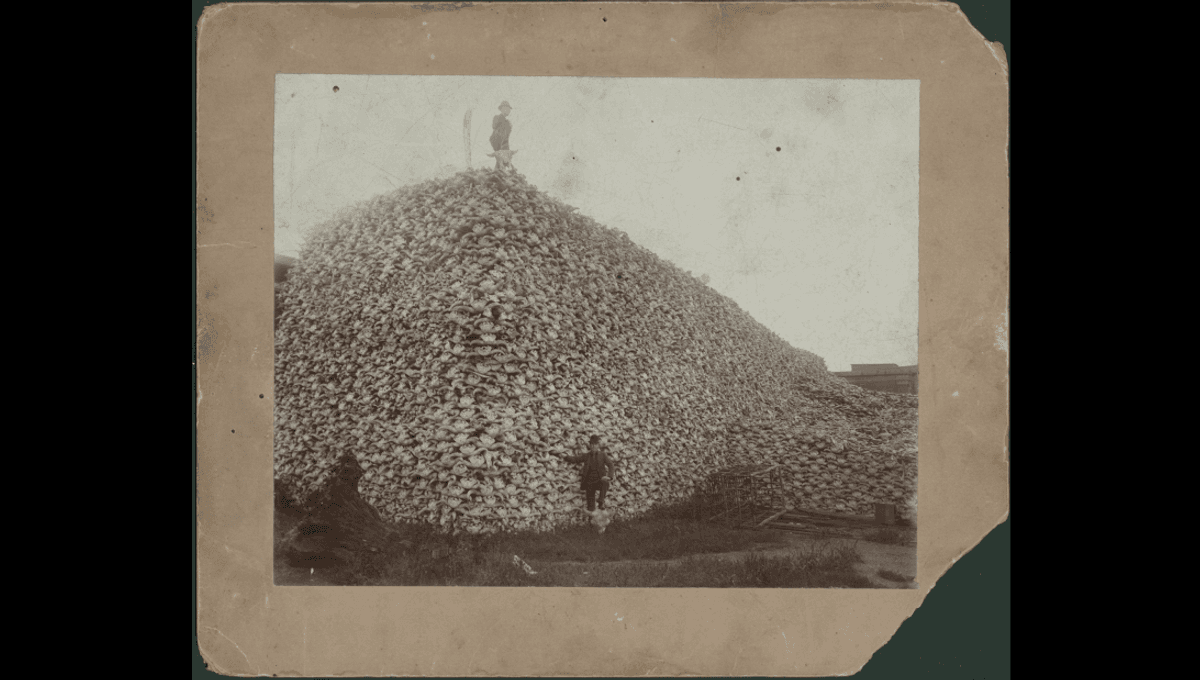
The above image was taken at the Michigan Carbon Works refinery in the United States back in 1892, a time when the number of bison in the country had plummeted to just 456 individuals. A shocking statistic in itself, and even more so in the context that at the close of the 18th century, there had been in the region of 30 to 60 million.
The refinery made a buck off processing the resulting bones of the colonization of the West, grinding them into glue and fertilizer, but capitalism wasn’t the only motivator driving the extermination of bison. The herds were a crucial part of Indigenous culture, and are still considered a relative of Plains Indigenous people, as according to the Buffalo Treaty.
The knock-on effects of the Great Plains bison slaughter
The communities that relied on bison experienced immediate and severe consequences that are well documented, but some of them were lasting. Recent research found that Native Americans experienced a significant loss in height after the extermination, as well as a rise in child mortality and a shift in their material wellbeing that is still present today.
Their extermination was so catastrophic because the presence of bison was crucial for making the Prairies liveable for human communities, and the consequences were no accident. Removing bison was a means of destroying enemy resources among US officials as high up as the president, writes The Atlantic. A brutal solution to what they perceived to be “The Indian Problem“.
It would be a devastating blow, almost wiping out an animal that provided sustenance, formed a crucial part of communities’ cultures, and represented a keystone species that shaped the landscape. The removal of keystone species can destabilize entire ecosystems, potentially wiping out the plant and animal diversity that’s as crucial to humans as it is to wildlife.
Bison’s influence on the environment
Like elephants, it could be argued that bison are owed a sizable wage for their ecosystem services. Insects thrive in their dung, tadpoles and frogs set up camp in the pools created by the depressions of bison rolling over, known as wallows. Then, you have the 450-900 kilograms (1,000-2,000 pounds) of sustenance a single bison represents. Consider that, and then look at the above photo, and it gives you an idea of the magnitude of what happened.
Writing for The Conversation in 2020, Danielle Taschereau Mamers, then a postdoctoral research fellow in English and Culture Studies at McMaster University, explains how new railways and roads made it easier to move cargo around. This encouraged the extractive industries of colonial capitalism to strip the environment of animal products, taking with them the special relationships between bison, the biodiversity they supported, and Indigenous Nations.
Looking ahead
The near-extinction of bison might seem like a harrowing tale from the past, but in truth, the threat remains at a time when being able to buy everything year-round has been normalized in many cultures. Can this mountain of bison skulls serve as a reminder that preserving ecosystems by living off the land and shopping locally (where possible) is a better and more sustainable way forward than purchasing from whoever struck up the best trade deal?
As historian Bethany Hughes told BBC Earth, there’s more to this historic photo than just reflecting on the past.
“Colonialism and capitalism travel together. To benefit from and encourage the kind of economic success [Michigan Carbon Works] had processing bison bones, [which] were the byproduct of the sometimes-violent tactics of American settler colonial expansion, was to benefit from – and participate in – colonial projects that stripped Indigenous peoples of land, nationhood, and culture.”
“This photo is not a bracing reminder of the harms of colonial pasts. It is an indictment on commercial consumption practices that obscure the material and ethical conditions that make luxuries like refined sugar readily available and seemingly benign.”
Source Link: The Harrowing History Of Why There Were Once Only 456 Bison Left In The US